
Winnicott's-transitional object and the play space-are more useful. With Slick Henry, however, one of a series of artists in Gibsons' fiction, certain concepts of D.W. The survey is inconclusive: Gibson proliferates images of prostheses in an exploratory fashion.

This essay surveys the protagonists of Mona Lisa Overdrive (1988) in the light of the concept of the prosthetic. to control and invasion, and the subject's need for prostheses-people or things that mediate our relation to the world and enable us to cope with, for instance, loss. Since Neuromancer, Gibson has turned increasingly to waiflike and vulnerable characters, and he has dramatized a conflict between the subject's vulnerability. The essay concludes by considering how Slick's constructions, autonomous rather than prosthetic, figure in the ending of the novel, where relations between the hard-boiled and the religious are otherwise driving Mona Lisa Overdrive into a cul-de-sac.Īs William Gibson's Matrix Trilogy appeared, relations between the hard-boiled element and mystic events in cyberspace became increasingly strained, and the treatment of relations between subjects and objects more ambivalent and conflicted. Winnicott's - transitional object and the play space - are more useful. With Slick Henry, however, one of a series of artists in Gibson's fiction, certain concepts of D.W.



Since Neuromancer, Gibson has turned increasingly to waiflike and vulnerable characters, and he has dramatized a conflict between the subject's vulnerability to control and invasion, and the subject's need for prostheses - people or things that mediate our relation to the world and enable us to cope with, for instance, loss. As William Gibson's MATRIX TRILOGY appeared, relations between the hard-boiled element and mystic events in cyberspace became increasingly strained, and the treatment of relations between subjects and objects more ambivalent and conflicted.


 0 kommentar(er)
0 kommentar(er)
